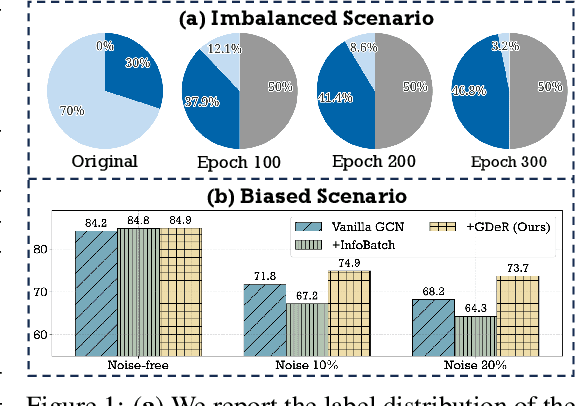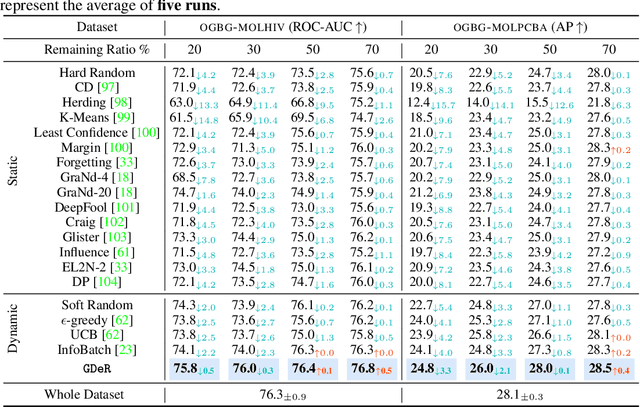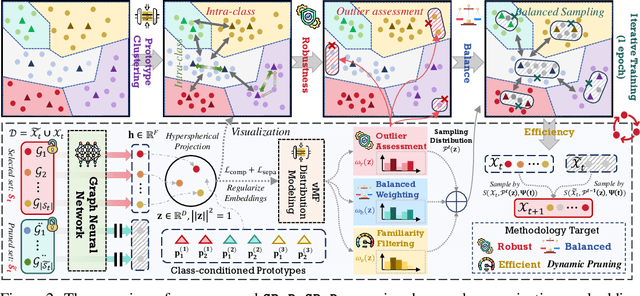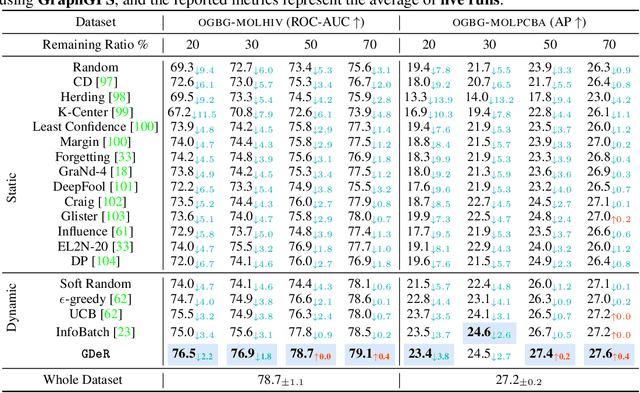Dawei Cheng
FinLMM-R1: Enhancing Financial Reasoning in LMM through Scalable Data and Reward Design
Jun 16, 2025Abstract:Large Multimodal Models (LMMs) demonstrate significant cross-modal reasoning capabilities. However, financial applications face challenges due to the lack of high-quality multimodal reasoning datasets and the inefficiency of existing training paradigms for reasoning enhancement. To address these issues, we propose an integrated framework, FinLMM-R1, combining an automated and scalable pipeline for data construction with enhanced training strategies to improve the multimodal reasoning of LMM. The Automated and Scalable Pipeline (ASP) resolves textual-visual misalignment in financial reports through a separate paradigm of question-answer generation and image-question alignment, ensuring data integrity and extraction efficiency. Through ASP, we collect 89,378 aligned image-question pairs from 23,397 financial reports, covering tasks such as arithmetic reasoning, statistics reasoning, financial explanation, and financial knowledge. Moreover, we introduce the Thinking with Adversarial Reward in LMM (TAR-LMM), extending the prior two-stage training framework [1] with additional reward mechanisms. In the first stage, we focus on text-only tasks with format and accuracy rewards to guide the model in generating well-structured thinking contents. In the second stage, we construct multi-image contrastive samples with additional reward components including image selection, thinking content length, and adversarial reward to jointly optimize the LMM across visual perception, reasoning efficiency, and logical coherence. Extensive experiments on 7 benchmarks show ASP-derived dataset and training framework significantly improve answer accuracy and reasoning depth over existing reasoning LMMs in both general and financial multimodal contexts.
CFBenchmark-MM: Chinese Financial Assistant Benchmark for Multimodal Large Language Model
Jun 16, 2025Abstract:Multimodal Large Language Models (MLLMs) have rapidly evolved with the growth of Large Language Models (LLMs) and are now applied in various fields. In finance, the integration of diverse modalities such as text, charts, and tables is crucial for accurate and efficient decision-making. Therefore, an effective evaluation system that incorporates these data types is essential for advancing financial application. In this paper, we introduce CFBenchmark-MM, a Chinese multimodal financial benchmark with over 9,000 image-question pairs featuring tables, histogram charts, line charts, pie charts, and structural diagrams. Additionally, we develop a staged evaluation system to assess MLLMs in handling multimodal information by providing different visual content step by step. Despite MLLMs having inherent financial knowledge, experimental results still show limited efficiency and robustness in handling multimodal financial context. Further analysis on incorrect responses reveals the misinterpretation of visual content and the misunderstanding of financial concepts are the primary issues. Our research validates the significant, yet underexploited, potential of MLLMs in financial analysis, highlighting the need for further development and domain-specific optimization to encourage the enhanced use in financial domain.
Language Model-Enhanced Message Passing for Heterophilic Graph Learning
May 26, 2025Abstract:Traditional graph neural networks (GNNs), which rely on homophily-driven message passing, struggle with heterophilic graphs where connected nodes exhibit dissimilar features and different labels. While existing methods address heterophily through graph structure refinement or adaptation of neighbor aggregation functions, they often overlook the semantic potential of node text, rely on suboptimal message representation for propagation and compromise performance on homophilic graphs. To address these limitations, we propose a novel language model (LM)-enhanced message passing approach for heterophilic graph leaning (LEMP4HG). Specifically, in the context of text-attributed graph, we provide paired node texts for LM to generate their connection analysis, which are encoded and then fused with paired node textual embeddings through a gating mechanism. The synthesized messages are semantically enriched and adaptively balanced with both nodes' information, which mitigates contradictory signals when neighbor aggregation in heterophilic regions. Furthermore, we introduce an active learning strategy guided by our heuristic MVRD (Modulated Variation of Reliable Distance), selectively enhancing node pairs suffer most from message passing, reducing the cost of analysis generation and side effects on homophilic regions. Extensive experiments validate that our approach excels on heterophilic graphs and performs robustly on homophilic ones, with a graph convolutional network (GCN) backbone and a practical budget.
Can LLMs Alleviate Catastrophic Forgetting in Graph Continual Learning? A Systematic Study
May 24, 2025Abstract:Nowadays, real-world data, including graph-structure data, often arrives in a streaming manner, which means that learning systems need to continuously acquire new knowledge without forgetting previously learned information. Although substantial existing works attempt to address catastrophic forgetting in graph machine learning, they are all based on training from scratch with streaming data. With the rise of pretrained models, an increasing number of studies have leveraged their strong generalization ability for continual learning. Therefore, in this work, we attempt to answer whether large language models (LLMs) can mitigate catastrophic forgetting in Graph Continual Learning (GCL). We first point out that current experimental setups for GCL have significant flaws, as the evaluation stage may lead to task ID leakage. Then, we evaluate the performance of LLMs in more realistic scenarios and find that even minor modifications can lead to outstanding results. Finally, based on extensive experiments, we propose a simple-yet-effective method, Simple Graph Continual Learning (SimGCL), that surpasses the previous state-of-the-art GNN-based baseline by around 20% under the rehearsal-free constraint. To facilitate reproducibility, we have developed an easy-to-use benchmark LLM4GCL for training and evaluating existing GCL methods. The code is available at: https://github.com/ZhixunLEE/LLM4GCL.
Effective High-order Graph Representation Learning for Credit Card Fraud Detection
Mar 03, 2025Abstract:Credit card fraud imposes significant costs on both cardholders and issuing banks. Fraudsters often disguise their crimes, such as using legitimate transactions through several benign users to bypass anti-fraud detection. Existing graph neural network (GNN) models struggle with learning features of camouflaged, indirect multi-hop transactions due to their inherent over-smoothing issues in deep multi-layer aggregation, presenting a major challenge in detecting disguised relationships. Therefore, in this paper, we propose a novel High-order Graph Representation Learning model (HOGRL) to avoid incorporating excessive noise during the multi-layer aggregation process. In particular, HOGRL learns different orders of \emph{pure} representations directly from high-order transaction graphs. We realize this goal by effectively constructing high-order transaction graphs first and then learning the \emph{pure} representations of each order so that the model could identify fraudsters' multi-hop indirect transactions via multi-layer \emph{pure} feature learning. In addition, we introduce a mixture-of-expert attention mechanism to automatically determine the importance of different orders for jointly optimizing fraud detection performance. We conduct extensive experiments in both the open source and real-world datasets, the result demonstrates the significant improvements of our proposed HOGRL compared with state-of-the-art fraud detection baselines. HOGRL's superior performance also proves its effectiveness in addressing high-order fraud camouflage criminals.
* 9 pages, 5 figures, accepted at IJCAI 2024
FinTSB: A Comprehensive and Practical Benchmark for Financial Time Series Forecasting
Feb 26, 2025Abstract:Financial time series (FinTS) record the behavior of human-brain-augmented decision-making, capturing valuable historical information that can be leveraged for profitable investment strategies. Not surprisingly, this area has attracted considerable attention from researchers, who have proposed a wide range of methods based on various backbones. However, the evaluation of the area often exhibits three systemic limitations: 1. Failure to account for the full spectrum of stock movement patterns observed in dynamic financial markets. (Diversity Gap), 2. The absence of unified assessment protocols undermines the validity of cross-study performance comparisons. (Standardization Deficit), and 3. Neglect of critical market structure factors, resulting in inflated performance metrics that lack practical applicability. (Real-World Mismatch). Addressing these limitations, we propose FinTSB, a comprehensive and practical benchmark for financial time series forecasting (FinTSF). To increase the variety, we categorize movement patterns into four specific parts, tokenize and pre-process the data, and assess the data quality based on some sequence characteristics. To eliminate biases due to different evaluation settings, we standardize the metrics across three dimensions and build a user-friendly, lightweight pipeline incorporating methods from various backbones. To accurately simulate real-world trading scenarios and facilitate practical implementation, we extensively model various regulatory constraints, including transaction fees, among others. Finally, we conduct extensive experiments on FinTSB, highlighting key insights to guide model selection under varying market conditions. Overall, FinTSB provides researchers with a novel and comprehensive platform for improving and evaluating FinTSF methods. The code is available at https://github.com/TongjiFinLab/FinTSBenchmark.
Semi-supervised Credit Card Fraud Detection via Attribute-Driven Graph Representation
Dec 24, 2024Abstract:Credit card fraud incurs a considerable cost for both cardholders and issuing banks. Contemporary methods apply machine learning-based classifiers to detect fraudulent behavior from labeled transaction records. But labeled data are usually a small proportion of billions of real transactions due to expensive labeling costs, which implies that they do not well exploit many natural features from unlabeled data. Therefore, we propose a semi-supervised graph neural network for fraud detection. Specifically, we leverage transaction records to construct a temporal transaction graph, which is composed of temporal transactions (nodes) and interactions (edges) among them. Then we pass messages among the nodes through a Gated Temporal Attention Network (GTAN) to learn the transaction representation. We further model the fraud patterns through risk propagation among transactions. The extensive experiments are conducted on a real-world transaction dataset and two publicly available fraud detection datasets. The result shows that our proposed method, namely GTAN, outperforms other state-of-the-art baselines on three fraud detection datasets. Semi-supervised experiments demonstrate the excellent fraud detection performance of our model with only a tiny proportion of labeled data.
* 9 pages, 5 figures, AAAI 2023, code: https://github.com/AI4Risk/antifraud
Efficient Dynamic Attributed Graph Generation
Dec 11, 2024Abstract:Data generation is a fundamental research problem in data management due to its diverse use cases, ranging from testing database engines to data-specific applications. However, real-world entities often involve complex interactions that cannot be effectively modeled by traditional tabular data. Therefore, graph data generation has attracted increasing attention recently. Although various graph generators have been proposed in the literature, there are three limitations: i) They cannot capture the co-evolution pattern of graph structure and node attributes. ii) Few of them consider edge direction, leading to substantial information loss. iii) Current state-of-the-art dynamic graph generators are based on the temporal random walk, making the simulation process time-consuming. To fill the research gap, we introduce VRDAG, a novel variational recurrent framework for efficient dynamic attributed graph generation. Specifically, we design a bidirectional message-passing mechanism to encode both directed structural knowledge and attribute information of a snapshot. Then, the temporal dependency in the graph sequence is captured by a recurrence state updater, generating embeddings that can preserve the evolution pattern of early graphs. Based on the hidden node embeddings, a conditional variational Bayesian method is developed to sample latent random variables at the neighboring timestep for new snapshot generation. The proposed generation paradigm avoids the time-consuming path sampling and merging process in existing random walk-based methods, significantly reducing the synthesis time. Finally, comprehensive experiments on real-world datasets are conducted to demonstrate the effectiveness and efficiency of the proposed model.
Fast Track to Winning Tickets: Repowering One-Shot Pruning for Graph Neural Networks
Dec 10, 2024



Abstract:Graph Neural Networks (GNNs) demonstrate superior performance in various graph learning tasks, yet their wider real-world application is hindered by the computational overhead when applied to large-scale graphs. To address the issue, the Graph Lottery Hypothesis (GLT) has been proposed, advocating the identification of subgraphs and subnetworks, \textit{i.e.}, winning tickets, without compromising performance. The effectiveness of current GLT methods largely stems from the use of iterative magnitude pruning (IMP), which offers higher stability and better performance than one-shot pruning. However, identifying GLTs is highly computationally expensive, due to the iterative pruning and retraining required by IMP. In this paper, we reevaluate the correlation between one-shot pruning and IMP: while one-shot tickets are suboptimal compared to IMP, they offer a \textit{fast track} to tickets with a stronger performance. We introduce a one-shot pruning and denoising framework to validate the efficacy of the \textit{fast track}. Compared to current IMP-based GLT methods, our framework achieves a double-win situation of graph lottery tickets with \textbf{higher sparsity} and \textbf{faster speeds}. Through extensive experiments across 4 backbones and 6 datasets, our method demonstrates $1.32\% - 45.62\%$ improvement in weight sparsity and a $7.49\% - 22.71\%$ increase in graph sparsity, along with a $1.7-44 \times$ speedup over IMP-based methods and $95.3\%-98.6\%$ MAC savings.
GDeR: Safeguarding Efficiency, Balancing, and Robustness via Prototypical Graph Pruning
Oct 17, 2024



Abstract:Training high-quality deep models necessitates vast amounts of data, resulting in overwhelming computational and memory demands. Recently, data pruning, distillation, and coreset selection have been developed to streamline data volume by retaining, synthesizing, or selecting a small yet informative subset from the full set. Among these methods, data pruning incurs the least additional training cost and offers the most practical acceleration benefits. However, it is the most vulnerable, often suffering significant performance degradation with imbalanced or biased data schema, thus raising concerns about its accuracy and reliability in on-device deployment. Therefore, there is a looming need for a new data pruning paradigm that maintains the efficiency of previous practices while ensuring balance and robustness. Unlike the fields of computer vision and natural language processing, where mature solutions have been developed to address these issues, graph neural networks (GNNs) continue to struggle with increasingly large-scale, imbalanced, and noisy datasets, lacking a unified dataset pruning solution. To achieve this, we introduce a novel dynamic soft-pruning method, GDeR, designed to update the training ``basket'' during the process using trainable prototypes. GDeR first constructs a well-modeled graph embedding hypersphere and then samples \textit{representative, balanced, and unbiased subsets} from this embedding space, which achieves the goal we called Graph Training Debugging. Extensive experiments on five datasets across three GNN backbones, demonstrate that GDeR (I) achieves or surpasses the performance of the full dataset with 30%~50% fewer training samples, (II) attains up to a 2.81x lossless training speedup, and (III) outperforms state-of-the-art pruning methods in imbalanced training and noisy training scenarios by 0.3%~4.3% and 3.6%~7.8%, respectively.
 Add to Chrome
Add to Chrome Add to Firefox
Add to Firefox Add to Edge
Add to Edge